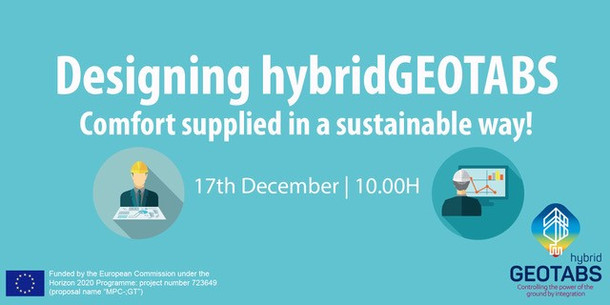Key takeaways from the Webinar - 17 Dec 20
Following up on the ’hybridGEOTABS webinar on “Introducing hybridGEOTABS: Comfort supplied in a Sustainable way!”, the webinar: “DESIGNING ’hybridGEOTABS Comfort Supplied in a sustainable way!” (17 December 2020) provided a deeper view on the design of the developed systems.
Dr. Eline Himpe (Ghent University) introduced the concept and the different components of the ’hybridGEOTABS system, underlying that the combination of geothermal energy and TABS (Thermally Activated Building System) can supply comfort in an energy efficient way during all seasons of the year.
Prof. Wim Boydens (Boydens Engineering) presented the main challenges that designers will have to face during the design phase of a ’hybridGEOTABS system. He pointed out on the flexibility that such systems can offer to building owners, providing them more options on matching low electricity prices from the grid and energy demand of the buildings to decrease operational costs.
Prof. Jelle Laverge (Ghent University) provided a deeper view on the design methods of ’hybridGEOTABS concept, highlighting the complexity of such systems but also their versatility, being applicable to a wide range of building types.
Pascal Simoens (Boydens Engineering) presented the developed tools that aim to assist the designer to carry out a feasibility study during the pre-design phase of a ’hybridGEOTABS system. By using this tool, designers can also simulate different system settings - such as building insulation - and calculate the impact of this decision on investment costs.
Dr. Damien Picard (University of Leuven) went through the main role and functions of the MPC (Model Predictive Control), providing also details on its interaction with the different HVAC systems, aiming to optimise the operation and overall efficiency of the system.
In the Q&A session panellists answered questions form the audience, clarifying information on the design, application and replicability of the tool. Below, are some takeaways from the Q&A session:
- Project clustering and the application of the ’hybridGEOTABS system at neighbourhood scale, would enable even higher economic and environmental benefits.
- Feasibility studies should be country specific, as apart from the climatic conditions and building physics, also national energy policies play a major role on the viability of a ’hybridGEOTABS system.
- ’hybridGEOTABS system provides a tested and reliable solution for implementing seasonal energy storage.
Download the slide-deck (pdf). Watch the webinar recording on the hybridGEOTABS YouTube Channel.
Do you want to learn more about GEOTABS? Have a look at REHVA’s Guidebook No. 20.

